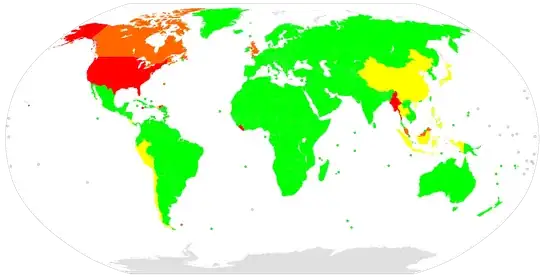What’s the actual base of the oft-repeated claim that besides the US only Liberia and Myanmar had not officially/fully/completely/… adopted the metric system? For which definition of “not metric” is it or was it true, if any?
Examples
(Emphasis added.)
Wikipedia article Metrication:
Since 2006, three countries formally do not use the metric system as their main standard of measurement: the United States, Myanmar, and Liberia.[3]→CIA WFB
Wikipedia article Metric system:
[Map caption:] Countries which have not officially adopted the metric system (United States, Myanmar, and Liberia)
…
Many sources also cite Liberia and Myanmar as the only other countries not to have done so.
…
According to the US Central Intelligence Agency’s Factbook (2007), the International System of Units has been adopted as the official system of weights and measures by all nations in the world except for Myanmar (Burma), Liberia and the United States,[…] while the NIST has identified the United States as the only industrialised country where the metric system is not the predominant system of units.[75]
CIA World Factbook, Appendix G:
Note: At this time, only three countries – Burma, Liberia, and the US – have not adopted the International System of Units (SI, or metric system) as their official system of weights and measures. Although use of the metric system has been sanctioned by law in the US since 1866, it has been slow in displacing the American adaptation of the British Imperial System known as the US Customary System. The US is the only industrialized nation that does not mainly use the metric system in its commercial and standards activities, but there is increasing acceptance in science, medicine, government, and many sectors of industry.
Only three nations do not use the metric system today: Myanmar, Liberia and the United States. But calling America a nonmetric nation is somewhat of a misnomer. The United States has given more than an inch even though it might not have gone the whole nine yards.
…
Still, America is the only industrialized nation in the world that does not conduct business in metric weights and measures.
Many, many other references abound. This is an oft-repeated claim, e.g. it’s an anecdotal “fact” often told by teachers introducing the metric system to (US) students.
Status
The statement sounds unfounded to me and is almost always used to shame Americans by associating them with two exemplary “backwards” countries. The claim has been around a while, at least since the 1970s when the UK and Commonwealth countries formally converted, but the political and commercial situation in many countries (including those notorious three) has changed since, e.g. significantly in Myanmar in 2011.
Wikipedia article Metrication:
Some sources now identify Liberia as metric, and the government of Myanmar has stated that the country would metricate with a goal of completion by 2019.[6][7]
…
- ^ The Liberian government has begun transitioning from use of imperial units to the metric system. However, this change has been gradual, with government reports concurrently using both systems. … [50]
- ^ In June 2011, the Burmese government’s Ministry of Commerce began discussing proposals to reform the measurement system in Burma and adopt the metric system used by most of its trading partners. … [51][52][53][54]
Wikipedia article Metric system:
However, reports published since 2007 hold this is no longer true of Myanmar or Liberia.[76] An Agence France-Presse report from 2010 stated that Sierra Leone had passed a law to replace the imperial system with the metric system thereby aligning its system of measurement with that used by its Mano River Union (MRU) neighbours Guinea and Liberia. [According to the Agence France-Presse report (2010) Liberia was metric, but Sierra Leone was not metric—a statement that conflicted with the CIA statement (2007).][77] Reports from Myanmar suggest that the country is also planning to adopt the metric system.[78]
The US have signed the Metre Convention early on and metric units are legal for almost all purposes, although sometimes dual-labeling is required and customary-only is frequently encountered (e.g. on road signs).
Many “metric” countries, most notatbly the UK, have some remnants of traditional local or colonial systems of measurement. US dominance in some industries or markets has also forced their English units into places where they haven’t been used before, e.g. inch-based typographic points or screens nominally sized in inches per diagonal.

